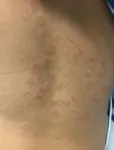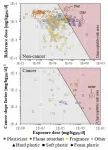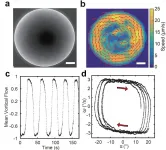CHOP experts describe types of rashes associated with MIS-C
Findings may help doctors and parents know when a rash warrants further examination for the inflammatory syndrome
2021-02-22
(Press-News.org) Philadelphia, February 22, 2021--In April 2020, pediatricians began recognizing a puzzling syndrome in children involving hyperinflammation that results in an array of symptoms, including fever, gastrointestinal distress and rash. The syndrome, thought to be a post-infectious complication of SARS-CoV-2 infection, was given the name Multisystem Inflammatory Syndrome Children, or MIS-C. However, diagnosing the condition has posed challenges, as many of its symptoms, including rash, are common in many other pediatric infections.
In a study published in Open Forum Infectious Diseases, researchers at Children's Hospital of Philadelphia (CHOP) describe the array of rashes seen in MIS-C patients at their hospital through late July 2020, providing photos and information that could help doctors diagnose future cases.
"We hope the information provided in this research letter will help general pediatricians and emergency department physicians who may wonder if a patient with a fever requires a more extensive examination," said Audrey Odom John, MD, PhD, Chief of the Division of Pediatric Infectious Diseases at CHOP and senior author of the paper. "Given that some rashes associated with MIS-C are distinctive, we also imagine these images could help many parents who are looking for signs that their child needs prompt evaluation."
The research team analyzed the MIS-C-associated rashes of seven patients seen at CHOP. Although the researchers did not observe a single, defining rash associated with COVID-19, there were several types of rashes that were common in these patients, both in appearance and location.
In terms of rash location, all patients in the study developed a rash on their lower body, and five of the seven patients had a rash on their inner thighs. Rashes on the chest and upper extremities were also common, occurring in four out of seven patients.
More than half of the patients presented with small-to-medium annular plaques, which look like dime-size circles, on their chest and back. More than half of the patients in the study also developed purpura, tiny red spots, often in the center of the dime-like annular plaques.
While some patients did develop a cherry-red rash on the bottoms of their feet and palms of their hands, this sort of rash was seen in less than half of the patients in the study. Rashes on the face were uncommon, and the rashes rarely itched.
"Depending on the age of the child, parents may not regularly look at the child's chest, back or thighs, but this is where the rashes associated with MIS-C tend to appear," said John. "Given that MIS-C is still largely a diagnosis of exclusion, parents and health care providers should look for rashes in these locations if the child has a fever that seems suspicious."
INFORMATION:
Blatz AM, Oboite M, Chiotos K, Castelo-Soccio L, Odom John AR, and the Children's Hospital of Philadelphia MIS-C Research Collaborative, "Cutaneous findings in SARS-CoV-2-associated Multisystem Inflammatory Disease in Children (MIS-C)," Open Forum Infectious Diseases, online February 16, 2021, DOI: 10.1093/ofid/ofab074
About Children's Hospital of Philadelphia: Children's Hospital of Philadelphia was founded in 1855 as the nation's first pediatric hospital. Through its long-standing commitment to providing exceptional patient care, training new generations of pediatric healthcare professionals, and pioneering major research initiatives, Children's Hospital has fostered many discoveries that have benefited children worldwide. Its pediatric research program is among the largest in the country. In addition, its unique family-centered care and public service programs have brought the 564-bed hospital recognition as a leading advocate for children and adolescents. For more information, visit http://www.chop.edu
[Attachments] See images for this press release:

ELSE PRESS RELEASES FROM THIS DATE:
2021-02-22
It has long been known that several chemicals used in plastic toys in different parts of the world can be harmful to human health. However, it is difficult for parents to figure out how to avoid plastic toys containing chemicals that may cause possible health risks to their children.
Regulations and labelling schemes are different across regions and countries, and there is no international agreement on which substances should be banned from use in toy materials. For the most part, regulations and international lists of 'chemicals of concern' in toys focus on certain substance groups with known harmful properties, such as phthalates, but do not cover the wider range of chemicals found in plastic toys.
Researchers from DTU ...
2021-02-22
With the COVID-19 pandemic taking a disproportionate toll on low-income people of color, a research team headed by Marya Gwadz of the Silver School of Social Work at New York University set out to understand the ways the pandemic may put individuals at risk for adverse outcomes, and the ways they successfully adapted to and coped with the emerging pandemic, focused on those from low-socioeconomic status backgrounds who have lived with HIV for a decade or longer.
The team's newly published study explores the effects of COVID-19 on engagement in HIV care, HIV medication use and overall wellbeing during the early stages of the ...
2021-02-22
About 70% of the world's main crops depend on insect pollination. Climate change is already affecting the abundance and distribution of insects, which could cause geographical mismatches between crops and their pollinators. Crops that rely primarily on wild pollinators (e.g., crops that cannot be effectively pollinated by commercial colonies of honey bees) could be particularly in jeopardy. However, limited information on plant-pollinator associations and pollinator distributions complicate the assessment of climate change impacts on specific crops. To study the potential impacts of climate change on pollination of a specific crop in North America, we use the case of open?field ...
2021-02-22
Macrocyclic peptides are promising candidates for pharmaceuticals, but their screening is difficult. Scientists have now developed an easy-to-use, high-throughput screening assay for cyclic peptides with affinity to ubiquitin, a protein that helps to degrade proteins and induce cell death. The results could lead to novel drug candidates against cancer, according to the study published in the journal Angewandte Chemie.
Drugs based on peptides (small proteins) are often too large to pass through cell membranes. To make such peptides more compact and stable--and thus more efficient--researchers are investigating their closed versions, called macrocyclic ...
2021-02-22
This new finding may pave the way for fabricating a new class of self-driven devices and materials, such as the ability to control the rhythmic movement of soft robots without relying on electronic circuits, and for the study of microbial physiology. It has been published in the scientific journal Nature.
A fast growing and interdisciplinary field, active matter science studies systems consist of units where energy is spent locally to generate mechanical work. Active matter includes all living organisms from cells to animals, biopolymers driven by molecular motors, and synthetic self-propelled materials. Self-organisation (the process of producing ordered structures via interaction between ...
2021-02-22
A SARS-CoV-2 tracker uses publicly available sequencing data to show how the virus is changing and spreading over time. The tracker, called CovMT, was developed at KAUST and is expected to help researchers and policymakers understand the evolution of the virus's mutations. This could have implications for vaccine development, patient treatment and the implementation of restrictions.
"As new variants of the SARS-CoV-2 virus emerge, authorities around the world need to know if these, or similar variants, have entered their countries," says computational biologist, Intikhab Alam, who designed ...
2021-02-22
Treating waste brine using a self-cleaning crystallizer that runs on solar power could be an eco-friendly and efficient way to make seawater desalination more sustainable.
In desert regions, seawater desalination provides essential freshwater for drinking and agriculture. A major problem is that the process generates vast quantities of concentrated brine that is often released into nearby lakes and rivers or back into the sea, harming vegetation and marine life. "With tightening environmental regulations and increasing public awareness, there is pressure to treat brine with zero liquid discharge," says Chenlin Zhang, a Ph.D. student in KAUST. This means extracting every last drop of water while leaving behind solid mineral crystals that can be salvaged for other uses.
Crystallization ...
2021-02-22
Monoclonal antibodies are part of the therapeutic arsenal for eliminating cancer cells. Some make use of the immune system to act and belong to a class of treatment called "immunotherapies." But how do these antibodies function within the tumor? And how can we hope to improve their efficacy? Using innovative in vivo imaging approaches, scientists from the Institut Pasteur and Inserm visualized in real time how anti-CD20 antibodies, used to treat B-cell lymphoma, guide the immune system to attack tumor cells. Their findings were published in the journal Science Advances on February 19, 2021
Anti-CD20 antibodies are used in clinical practice to treat patients with B-cell lymphoma, a type of blood cancer. The treatment, often used in combination with chemotherapy, has been ...
2021-02-22
A mixture of smaller countries led by New Zealand, Vietnam, Taiwan, Thailand, Cyprus, Rwanda and Iceland led the world 's Top 10 countries to manage their COVID-19 response well, according to a new study.
In the study, published in The BMJ, lead researcher Flinders University's Professor Fran Baum joined experts from around the world to reflect upon the Global Health Security Index (October 2019) predictions for a public health emergency.
Along with Australia, Latvia and Sri Lanka among the best responders, the list highlights some of the 10 key causes of why some countries were successful or not in containing COVID-19 pandemic over the past year.
The US, UK, Netherlands, Australia, Canada, Thailand, Sweden, Denmark, South Korea, Finland (France, Slovenia and Switzerland) ...
2021-02-22
People with periodontitis are at higher risk of experiencing major cardiovascular events, according to new research from Forsyth Institute and Harvard University scientists and colleagues.
In a longitudinal study published recently in the Journal of Periodontology, Dr. Thomas
Van Dyke, Senior Member of Staff at Forsyth, Dr. Ahmed Tawakol of Massachusetts General Hospital, and their collaborators showed that inflammation associated with active gum disease was predictive of arterial inflammation, which can cause heart attacks, strokes, and other dangerous manifestations of cardiovascular disease.
For ...
LAST 30 PRESS RELEASES:
[Press-News.org] CHOP experts describe types of rashes associated with MIS-C
Findings may help doctors and parents know when a rash warrants further examination for the inflammatory syndrome




